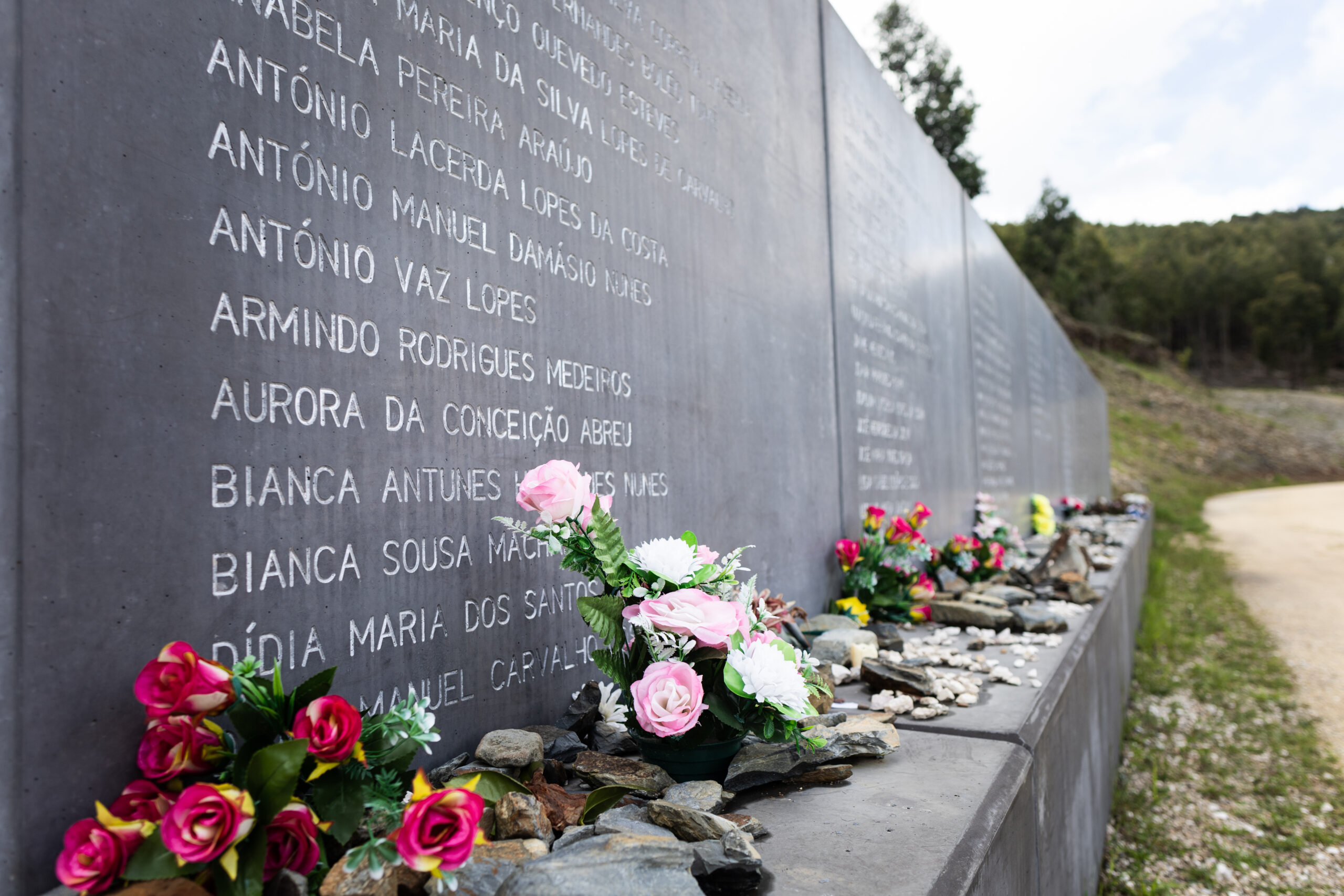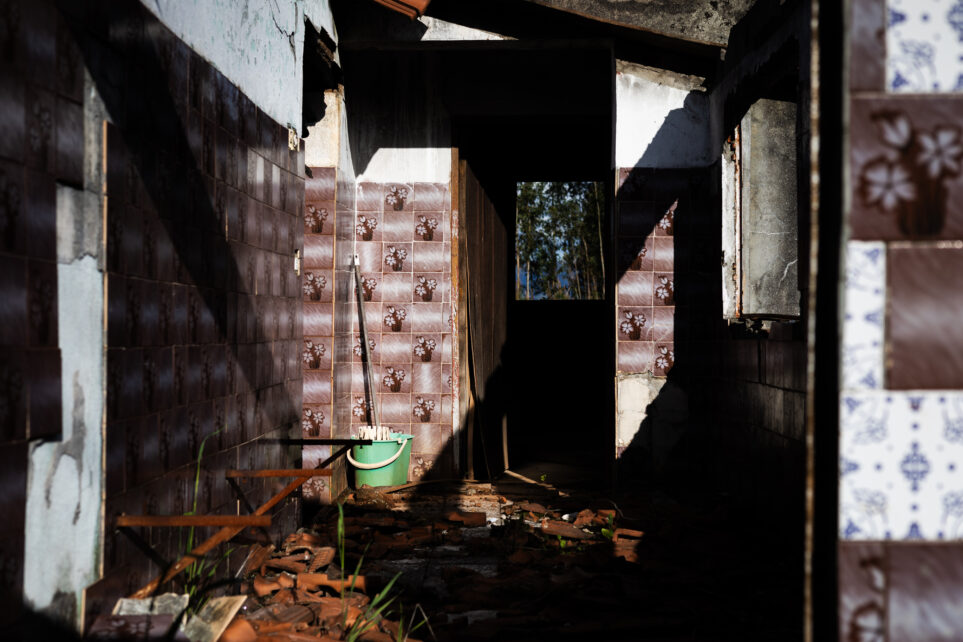The 116 deaths that woke up a country

This article is part of a series of three articles from El Diario’s larger multimedia project on mega-fires in Europe by Mariangela Paone, Raúl Rejón, Sofía Pérez and Raúl Sánchez. Introduction | Part I | Part II | Part III
Pedrógão Grande (Portugal)
The water in the pool of Nordeirinho, a village hidden among pine and eucalyptus trees in central Portugal, is so muddy that the liquid has the feel of mud. It is improbable to think that this cubicle, just over two meters long and one meter wide, saved the lives of a group of neighbors in June 2017 in the deadliest fire in the country’s history. Sixty-six people died, most of them trapped in their cars or running through the forest as they tried to flee the flames. In some cases the fire did not even touch their bodies. The air was so hot and hurricane-like that it killed. Only 11 of Nordeirinho’s then 40 inhabitants have survived to tell the tale.
Seven years later, the lush forests of the area are no longer a mirror of what happened but the inhabitants are still dealing with the consequences of an event that condemned them to bury friends, neighbors and relatives without rest for a whole week. “We were a martyred people and I want to think that what happened happened because the country had to wake up and realize what was coming with climate change,” says Dina Duarte, president of the Association of Victims of the Pedrógrão Grande Fire (AVIPG).

/ Matilde Fieschi
Portugal is the European country that has suffered the most major fires – those affecting more than 500 hectares – since the beginning of the century. It also gains in burned surface: two million hectares have been razed in the last twenty years in 865 fires. At the fire declared in the parish The fire in Pedrógrão Grande after a power line came into contact with a chestnut tree was followed in October of the same year by another large fire – the second worst since 2000 in Europe – which left 50 more dead in the regions of Coimbra, Viseu and Aveiro while the country was still mourning the dead of June. 116 deaths in just four months.
“I really don’t see the way, I can’t see how we are going to prevent the big fires that are already happening and those that will come in the future. At this point, the objective is that they cause as little damage as possible to the environment and to people,” says Joaquim Sande Silva, a professor specializing in fire ecology at the Polytechnic Institute of Coimbra and an expert on the independent commission that investigated the two big fires seven years ago on behalf of the Assembly of the Republic (the equivalent of the Spanish Congress of Deputies). In his temporal analysis, the cycle of terror did not start in 2017 but in 2003, when many fires declared in dozens of points swept the country from Castelo Branco to Beja.

Portugal has a dangerous triangle of conditions that make it very fragile in the face of fire, according to the expert. On the one hand, a Mediterranean forest “attenuated” with rains that make the vegetation grow a lot and “a heat that dries out all that biomass”. On the other, a culture of burning to “clear the forest” and, finally, a disorganized response to firefighting and little work, at least until 2017, on prevention. Most of the firefighters are volunteers.
If there is a turning point, this is precisely 2017. Portugal made the front pages of all the international media due to the number of fatalities. The images of the burned cars in the middle of the road went around the world and the impact they caused abroad also pushed for changes in the country. The shock, say several sources consulted for this report, awakens the conscience of policy makers.

The Socialist government of the time, led by António Costa, created a specialized public entity, the Agency for the Integrated Management of Rural Fires (AGIF), and launched a national action program. Francisco Ferreira, president of the environmental association Zero, explains that the plan included “97 projects for the care of rural areas, behavior modification and efficient risk management” that have been evaluated year by year.
“Some results have been seen. For example, if 80% of the investment was allocated in 2017 to firefighting, in 2022 the percentage was 39% and the rest has shifted to prevention,” says Ferreira, who stresses that since then there have been no casualties and “there has been a 50% reduction in the number of fires.” In the periods following the dismal year of fatalities there has been substantial improvement, with the exception of 2022, when major fires were recorded in many areas of the country with more than 100,000 hectares burned.
Sande Silva is more critical of the form of prevention adopted by the institutions. Since 2018, owners of forest land have been obliged to “clear” the area of scrub under threat of a fine of up to 120,000 euros. In addition, roadsides must be cleared in the area closest to the asphalt -in 2017 several trees fell on the road- and in the nuclei with houses the tops of pine and eucalyptus trees must be separated by at least ten meters and by four if they are other species. “We are working on comparing cut and uncut areas and we see no differences in terms of fire advance,” the professor maintains.

The north of Portugal, like the northern facade of Spain, has a problem with eucalyptus trees. The invasive species has become rampant: it occupies some 845,000 hectares, more than 25% of the total forest area in the country, confirms Ferreira. An attempt has also been made to curb this by limiting the planting of new areas by decree in 2018. Since then, developers must guarantee that they restore an area twice as large as the one they intend to plant and the bureaucracy to do so has increased, says the president of the environmental association.
“With every fire there has been an expert report and then the conclusions are only partially implemented. Until it happens again. I repeat a lot that it’s not just waiting for the fire to come and pouring water,” says the professor from the Polytechnic Institute of Coimbra, who is in favor of the “professionalization” of the fire department as a key element of firefighting in the future.

Sergio Lourenço is deputy commander at the Pedrógrão Grande fire station. He would be sitting in the dock right now, along with ten others charged with negligent homicide, were it not for the fact that his boss sent him to another fire that was not in his area. In Portugal the first commander to arrive at a fire becomes the coordinator. A court of first instance in Leiria acquitted all in 2023 but the Public Prosecutor’s Office has appealed the sentence and the process continues.
Would they be prepared today to take on a fire like the one in 2017? “Not for something that big that burned at that speed. I don’t think so now either. The fire traveled 20 kilometers in 20 minutes,” says Lourenço, moving his finger very fast from east to west as he points to the horizon. The fire caused a meteorological phenomenon called downburst , which occurs when a column of hot gases collapses. This burst created very strong air currents that pushed the fire at high speeds – what neighbors remember as “fire tornadoes” – and also displaced incandescent materials.

The firefighter believes, however, that citizens are more knowledgeable now. That they would not repeat that chaotic escape born of panic. Most of the deaths occurred on the road linking Figueiró dos Vinhos and Castanheira de Pera. There were neighbors trying to escape; others had the misfortune to be passing by at that very moment. “There were people who had just come from spending a wonderful day at a river beach in the area,” recalls AVIPG’s Dina Duarte.
“To think that so many people died is still an immense upheaval. We are here to help and we manage to do practically nothing,” Lourenço recounts with a thread of voice catching in his throat. Behind the eyes there is a kind of defeat. Then, after the critical moment, he manages to remember in detail the people who got into the fire engine on the first day of the fire. He was engaged in picking up injured people who were walking like zombies drifting along the road to take them to the evacuation helicopter. He describes the image in the rearview mirror of the car, the voracious advance of the flames reflected in the mirror, on the verge of tears.
To enter the burned territories is not to get into the guts of the fire but into something that is much more lasting: the memory of the flames. Its inhabitants were robbed of the privilege -and the innocence- of living the uncomfortable days of heat and wind without fear. “What happened here was a warning for the whole of Europe. It was a ‘look what is starting to happen’,” notes Duarte, who receives elDiario.es in the old school of Figueira (Graça), headquarters of the association since the facility is not used because there are no children in the village.

The organization has set up a small exhibition of deformed objects, unrecognizable due to the effect of the fire: a mottled ceramic cup, a piece of steel that belonged to a car, a pair of prescription glasses… At the top, a mural remembers all the victims with their names and surnames. Duarte puts his finger on one: Bianca Antunes Henriques. He was three years old and died in Nordeirinho trying to escape the fire with his grandmother. She was the only girl in the village.
“We set this up to keep the memory of the people who passed away. To remind the states to be prepared because we, the citizens, put our trust in them to protect us,” he proclaims before tears choke his eyes again. The guilt of those who stayed behind and the “why wasn’t it us, but them?” still keeps him awake at night.



